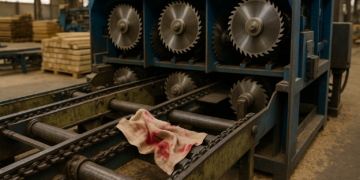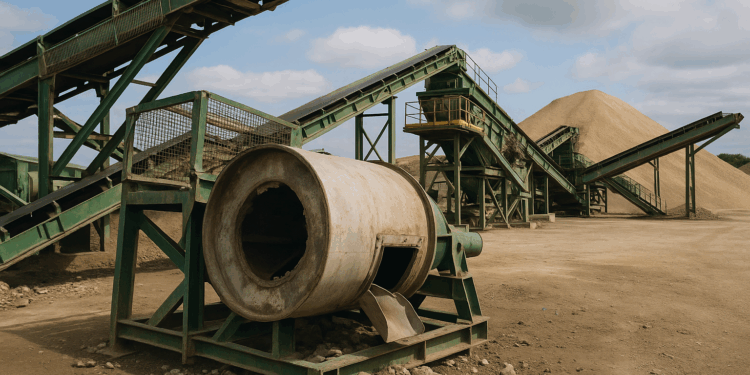Story Highlight
– Employee injured due to safety procedure breach.
– Timely intervention prevented potential death.
– Stonegrave Aggregates previously fined for safety violations.
– Company admitted breach before trial commenced.
– £270,000 fine imposed for ongoing safety issues.
Full Story
A serious incident at a quarry in County Durham has led to court proceedings highlighting critical failures in health and safety practices by Stonegrave Aggregates, the company operating the site. The incident, which occurred in March 2023, raised grave concerns about the safety measures in place for employees working with potentially dangerous machinery.
During a hearing at Teesside Crown Court, prosecutor Ellen Shaw revealed that a 59-year-old worker was cleaning debris from the drum of a picking line when the machinery was unexpectedly restarted. A supervisor, unaware of the employee’s presence inside the drum, unwittingly enabled this to occur. Fortunately, another colleague, realising the danger, activated the emergency stop button just in time. This timely intervention prevented what could have been a fatal incident.
The experienced worker, who has spent 15 years in the industry, sustained significant injuries as a result of the incident. These included a fractured shoulder, torn ligaments, a broken little finger on his right hand, along with bruises and back trauma. He required two weeks off work to recuperate from his injuries.
Shaw emphasised the severity of the situation during the court session, stating, “Death could easily have occurred but for the timely intervention of another member of staff. But that was through luck rather than design.” This assessment underscores the critical need for stringent adherence to safety protocols in the workplace, particularly in hazardous environments such as a quarry.
The court further heard that the Health and Safety Executive (HSE) had been alerted following the incident and discovered multiple breaches of health and safety regulations related to the picking line. These violations included an inadequate risk assessment process and a failure to identify the hazards posed by the machinery. Shaw pointed out that the company had effectively neglected to ensure compliance with its operational guidelines.
“The prosecution says systems were in place but not effectively implemented. So, it has written procedures but didn’t effectively adhere to them,” she noted. Such oversights raise serious questions about the operational standards maintained at Stonegrave Aggregates, particularly since the company had already faced legal repercussions in the past for similar infractions.
In fact, Stonegrave Aggregates had previously been fined in 2021 due to an incident that resulted in the death of one worker and serious injuries to another in 2015, indicating a troubling pattern of safety violations. Shaw suggested that the company had relied on expedient solutions to manage machinery issues, which significantly jeopardised employee safety. “Quick fix measures were taken to clear debris from machinery, putting employees in danger,” she asserted, adding that this lax approach continued for an extensive period.
Despite having updated procedures in 2016, the company failed to monitor or enforce these changes effectively right up until the time of the accident. On the day the trial was poised to commence in August, Stonegrave Aggregates admitted to breaches of health and safety regulations.
Counsel for the company, James Buchanan, conveyed the seriousness of the situation to the court. He revealed that shortly after the breach in May 2023, the Ashcourt Group became the new owners of Stonegrave Aggregates and expressed their apologies for the incident. “It took measures to remedy what was a wholly unsatisfactory state of affairs and, luckily, there has been no repetition under the new ownership, with completely new management in place,” he stated.
Buchanan highlighted the prior existence of safety protocols that were clearly communicated to the workforce, suggesting that there had been a widespread disregard for these measures. He also noted that, fortunately, the injuries incurred were less severe than those that might have resulted from a more grave scenario.
In conclusion, Judge Richard Clews reaffirmed that proper safety procedures were not adhered to during the incident involving the experienced worker trapped in the drum. The judge remarked on the compounded nature of the case, noting that the breach in safety practices had persisted over time and that there had been a history of tragic accidents at the site. A fine of £270,000 was imposed, alongside an additional £15,637 to cover the costs incurred by the HSE, to be settled within a year. As the legal consequences unfold, the focus remains on improving safety in such crucial operational environments to avoid future tragedies.























This incident is a stark reminder that written procedures alone are not enough. Controls must be reliable, risks must be reassessed after any change in task, and workers must be empowered and trained to stop work when it is unsafe. Lockout and isolation must be enforced every time equipment is cleaned or maintained, and supervisors must verify compliance rather than assume it. Organisations must learn from this case and take prompt action to protect people before another preventable injury occurs.
This case is a stark reminder that written procedures alone are not enough. When people are working near live machinery robust isolation controls competent supervision and regular verification that safety systems are followed are essential. Employers must ensure risk assessments are accurate staff are trained to a high standard and that safety critical tasks have clear safe systems of work that are enforced every time. Enforcement action in incidents like this should prompt immediate review of procedures and culture so that near misses are not treated as acceptable and workers are not left relying on luck to stay safe.
This case is a stark reminder that procedures on paper are not enough. Lockout tagout and safe isolation must be actively supervised and enforced every time machinery is accessed for cleaning. Training alone will not prevent incidents unless competence is clearly demonstrated and supervisors hold people to account. Regular audits of processes and behaviour, near miss reporting that leads to real change, and a visible safety culture from senior managers are essential to prevent a repeat.
This incident is a stark reminder that written procedures alone are not enough. Teams must ensure lockout procedures are followed every time machinery is cleaned or maintained and that controls cannot be bypassed. Competent supervision, clear responsibility for isolating plant, and regular practical training and audits are essential to stop near misses becoming fatalities. Employers must learn from repeated failures and take urgent action to protect workers.